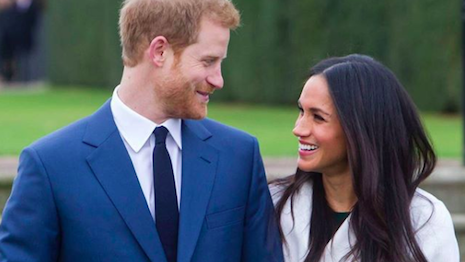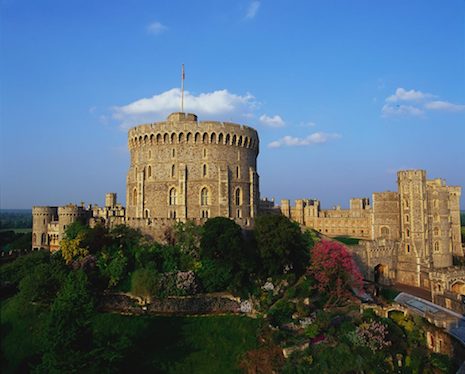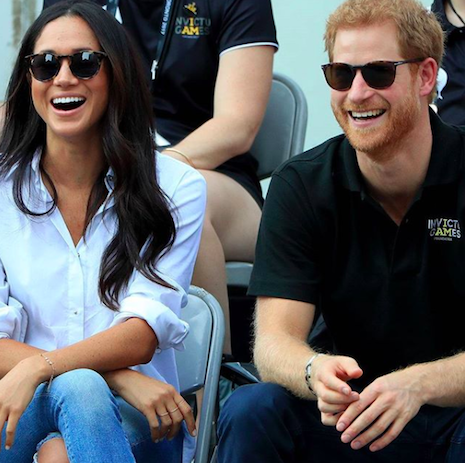 HRH Prince Harry and Meghan Markle will wed next year. Image credit: Clarence House
HRH Prince Harry and Meghan Markle will wed next year. Image credit: Clarence House
HRH Prince Henry of Wales and Meghan Markle’s wedding is still months away, but the buzz surrounding the royal marriage has already started.
Given the British luxury industry’s considerable ties to the royal family, brands frequently align themselves with major events in the their lives. The monarchy already provides a boost to the United Kingdom economy through brand positioning and tourism, but next year’s nuptial celebrations may provide further benefit to luxury purveyors.
"In 2012, Brand Finance estimated the uplift of the Diamond Jubilee celebrations to tourism at 390 million pounds, including hotel bookings and merchandise sales," said David Haigh, CEO of Brand Finance, London. "It could be expected that the royal wedding next year generates a similar or even larger value.
"Hundreds of thousands of foreign visitors are expected to arrive in London next year. 2011, when the previous royal wedding took place, saw a year on year increase of 800,000 visitors, including 250,000 holiday makers," he said. "With the recession a memory of the past, global mobility increasing, and the pound depreciating, tourist numbers are likely to be even higher for Harry and Meghan’s wedding next year.
"The wedding is also likely to boost the value of earned media coverage for Brand Britain around the world, estimated by Brand Finance at 125 million pounds this year. There will also be an uplift to the media industry with printed features and broadcast documentaries being commissioned. British TV stations are also set to attract additional revenue from broadcasting and licensing rights."
Royal wedding
Following months of speculation over impending wedding plans between Britain’s Prince Harry and Ms. Markle, the couple has announced their engagement.
Prince Charles issued an official statement about his son’s engagement on Nov. 27 (see story). The following day, Kensington Palace revealed that the wedding would take place in May at St. George’s Chapel in Windsor Castle.
Windsor Castle. Image credit: Royal Collection Trust
Ahead of Prince William’s marriage to Kate Middleton in 2011, a report from Barclays Corporate found that the interest in the couple’s wedding and the bride-to-be boosted luxury apparel sales. The effect was projected to last for three years, growing Britain’s luxury fashion sector by 29 percent to 2014 (see story).
Tourism also saw an uplift from the spectacle and interest in the country surrounding the wedding.
The Office of National Statistics said that 800,000 more visitors traveled to the U.K. in 2011 than in 2010.
Visit Britain also projected at the time that the wedding would have a prolonged effect on tourism, bringing in 4 million more travelers over the following years. The tourism bureau estimated the monetary value of these tourists to be 2 billion pounds.
However, the agency has not confirmed whether reality lived up to expectations, per The Telegraph.
Internal emails from Visit Britain obtained by The Guardian suggest that some may actually choose to stay away during the hubbub, driving tourist numbers down.
While Prince Harry’s wedding is expected to be a less opulent affair than his older brother’s due to his further distance from the throne, the event could create a similar boost for travel and retail in Britain in the long-term.
As an American, Ms. Markle could also attract an audience of U.S. visitors.
Much like the so-called “Kate Middleton Effect,” in which garments the Duchess of Cambridge wears sell out, Ms. Markle appears to have a similar effect on consumption.
Following the actress’ first appearance with her now-fiancée at the Invictus Games in September, the pair of Finlay & Co. sunglasses she wore attracted attention, crashing the brand’s Web site and leading to sales of about $27,000 in one night.
Meghan Markle with Prince Harry at the Invictus Games. Image credit: Clarence House
An unaffiliated Web site dubbed Meghan’s Mirror provides information for fans to get the “Suits” star’s look, from Stuart Weitzman booties to a Prada tote bag. While Ms. Markle was in the public eye for years due to her acting career, the blog was founded when she began dating the prince, which earned her more notice.
According to research by Brand Finance, the British monarchy has a value of 67 billion pounds, or about $89.5 billion. Since the firm began studying the royal family’s worth as a brand in 2012, its value has risen each year.
By Brand Finance’s calculations, the British monarchy created a gross uplift of 1.766 billion pounds, or about $2.3 billion, to the U.K. economy in 2017. While some of this came from tangible assets such as the Crown Estate, much of their impact comes from boosting the perceived value of goods with royal warrants or drawing tourists.
"As part of the study on the added value of the Monarchy for the U.K. economy, Brand Finance has examined the uplift to British brands which can be specifically attributed to unofficial endorsements by members of the Royal Family - sometimes called the ‘royal effect’, or in relation to the Duchess of Cambridge in particular – the ‘Kate effect,'" Mr. Haigh said. "The price and volume premium that British producers can thank the Royal Family for is estimated to be a whopping 200 million pounds a year.
"A lot of value generated by the Monarchy comes from the Duchess of Cambridge’s Midas touch and the extra sales of fashion brands that she is seen wearing," he said. "Meghan Markle is an accomplished actress in her own right, with a global popularity and a strong personal brand. It can be expected that she will join the Duchess of Cambridge as a great ambassador of the monarchy and British brands in general, especially in her native United States and in Canada where she had recently lived."
Monarchy marketing
Many brands within Britain’s luxury industry have ties to the monarchy, including a number that hold royal warrants. Prince Harry picked one of these chosen purveyors, Cleave and Company, to create the engagement ring for his fiancée.
Luxury brands often make special products in honor of the royal family’s milestones.
For instance, retailer Fortnum & Mason honored the 90th birthday of Queen Elizabeth II with the launch of a limited-edition honey.
Named Queen Bee, the honey was the only product created by the retailer to commemorate her milestone year, as she entered her ninth decade in April 2016. This as a tribute to Fortnum & Mason’s longstanding association with the royal family, as it holds a royal warrant and has served as the monarchy’s grocer for more than 150 years (see story).
Around the last royal wedding, properties such as Ritz-Carlton, London and Mandarin Oriental Hyde Park launched special packages and events to allow guests to celebrate the occasion.
Following the engagement announcement, a number of brands took to social media to share their congratulations and incorporate themselves into the conversation.
Harvey Nichols took a humorous approach on the news, sharing its illustration of “Quince Harry and Meghan Sparkle,” which depicted the royal as a fruit and his future wife as a bottle of Champagne.
Fortnum & Mason also offered a somewhat cheeky take on the engagement announcement, offering “one ginger that’s still on the market,” a tin of cookies.
"The respect for the institution of monarchy boosts the price and volume premium of brands boasting a royal warrant or a coat of arms," Brand Finance's Mr. Haigh said. "Luxury brands in particular can hope for significant commercial benefits from leveraging their association with the monarchy. We have estimated that this year, royal warrants and coats of arms were responsible for an overall uplift of over 210 million pounds to U.K. brands.
"The official royal endorsement remains highly beneficial to brands, especially those exporting to emerging markets such as China and the Middle East," he said. "An academic experiment by the University of Warwick’s Professor Qing Wang indicated that 70 percent of Chinese shoppers would rather buy a product with than without a royal warrant.
"Coats of arms are also a powerful marketing tool. They are a mark of quality, confirming the company’s reputability. With an appropriate strategy in place, they can influence stakeholder perceptions and help build brand equity.
"Unfortunately, many brands which have a coat of arms, do not utilize its full marketing potential, and many that would be eligible – which includes those domiciled across the Commonwealth and in the United States – are not aware of the opportunity."


